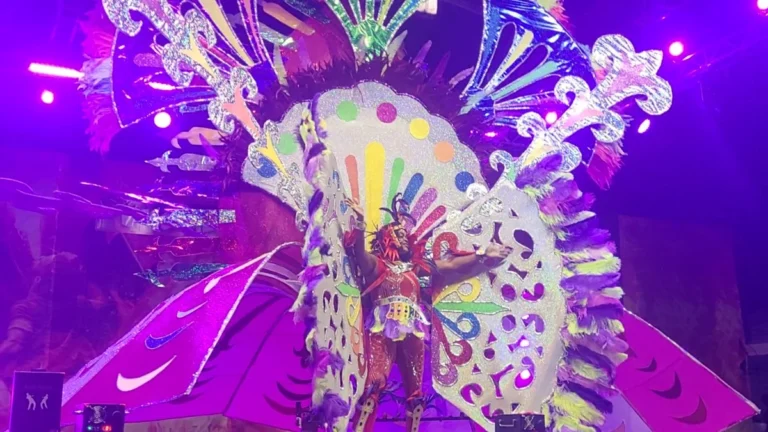St Vincent & the Grenadines’ Vincy Mas Honors Caribbean Culture

Vincy Mas Carnival 2025 in St. Vincent & the Grenadines. Photo: teleSUR
July 10, 2025 Hour: 11:10 am
A colorful Mardi Gras parade through the streets of Kingstown marked the closing of the carnival.
On Thursday, July 8, Vincy Mas, the official carnival celebration of Saint Vincent and the Grenadines, a multi-island nation in the Caribbean, concludes to the rhythms of soca and calypso.
RELATED:
The colorful Mardi Gras parade through the streets of the capital Kingstown marked the closing of the carnival that has become one of the most awaited celebrations in the Caribbean, with activities aimed at highlighting local culture in every corner of the country.
A Caribbean Carnival
You can feel it in every decorated corner of Kingstown, in the open-door band camps where costumes are being made until the last minute, in the speakers testing sound in Victoria Park: the people of St. Vincent and the Grenadines have been waiting patiently for these carnival days to arrive. Along with the Christmas season, this is one of the busiest cultural times of the year.
The fact is that in the Caribbean, carnival has a particular charisma: over the centuries it has become a celebration of the cultural heritage of these lands, marked by migratory movements and anti-colonial resistance.
“Carnival is part of the history of the Caribbean, of all its different territories,” notes Vincentian historian and musician Dr. Cleve Scott. “It originated in the inmediate post-emancipation period and developed mostly in Trinidad around the late 19th century. From there it has moved throughout the Caribbean and its diaspora.”
More than the continuation of a European tradition, it is possible to think of the Caribbean carnival as a re-foundation of this festivity, as a space of reappropriation and resistance to domination. Once slavery was abolished in the 19th century, the population made the celebration their own, bringing elements of their African and native culture that turned the carnival into a space of popular emancipation and defense of freedom.
To the Beat of Calypso and Soca
Everything that can be heard in the streets of St. Vincent during carnival time speaks of that cultural mix typical of the Caribbean, transmitted from island to island and proudly inherited from generation to generation. Calypso and soca, both traceable to Trinidad and with a strong African influence, take center stage: the former conveys a sharp look at society through a witty lyric, while soca captivates the youngest with its energy and festive dance.
Day after day of carnival, the streets dance and sing to the new songs that have been produced for this edition of Vincy Mas 2025. And in the renowned Victoria Park, where the main carnival competitions take place, the finalists of both genres perform their interpretations under the watchful eyes of the public and the judges, who choose the year’s monarchs.
“A world without soca would not be a world,” suggests Geo, one of the young performers at the Ragga Soca Monarch, as he comes down from stage. “To be honest, soca is a type of music, an art form that doesn’t implicate violence, it doesn’t implicate bad energy, it’s all about having fun, letting go, being free, loving each other and just enjoying yourself. So, soca will never be out of the picture. Not as long as we are alive!”
Let the Steelpans Ring
Another sign of the regional culture is the metallic rhythm of the Steel Bands, a form of percussion that also originated in Trinidad and has become the signature beat of the Caribbean festival. The Panorama is the moment of greatest visibility of the steel drums, when the best orchestras of the region compete for the highest honor.
In addition to being a moment of regional exchange, with bands from different countries meeting year after year to dance to the metallic beat, the carnival allows new generations to join the steelpan art. This is the case of the Epic Sound Steel Orchestra: its director, Johnny Pompeya, stresses the importance of adding the youngest to the bands so that, someday, they continue the legacy. “It means so much to me that I have these young people who are willing to allow me to teach them”, Pompeya tells us at the end of an energetic performance at Victoria Park. “They take on all the stress that I give them and make it possible for this artform to continue. Because the younger ones have to take it along, when I’m gone.”
Traditional Mas: the Celebration of Artisan Work
While carnival on different Caribbean coasts shares many of the same components – the masquerades, the steel bands, the calypso and soca competitions – locals like to point out that in St. Vincent and the Grenadines, it all takes on a special color. What distinguishes Vincy Mas from other similar festivities in the region is its appreciation of the craftsmanship that makes the carnival possible.
The traditional bands – the Vincentian equivalent of the Cuban comparsas, or Brazilian samba schools – keep the art of hand-made costumes alive: instead of importing a standardized, commercial image of carnival, they prefer to make their costumes with local or easily accessible materials, with which they seek to tell a story through the streets of Kingstown.
“We are not like other bands, who maybe have special machinery,” Alvern ‘Ali’ Cadogan, director of renowned mas band Nelson’s Bloc, explains to teleSUR. “We do everything by hand. We do a traditional mas, trying to tell a story in the streets that surprises the audience, carrying out an idea in an unexpected way. That is what we are all about.”
We speak with Ali just hours before the carnival costume presentation, and at Nelson’s Bloc camp everything is still in motion. The bands are working up to the last minute on their designs, with the King and Queen’s costumes as the centerpieces of the show. “This is unique to St. Vincent,” Ali adds. “In other carnivals, you only see feathers and beads everywhere. What you see in Brazil, you see in Miami, you see in Trinidad, you see in New York. And that’s not what we want. What we try to do is to depict a storyline and this is something we try to maintain.”
Local Pride and an Open Invitation
In a country that is committed to strengthening regional tourism, Vincy Mas becomes an ideal opportunity to invite the rest of the region to visit the islands in full celebration of their local culture. “It is unique,” highlights Prime Minister Ralph Gonsalves in an exclusive conversation with teleSUR.
“There is a generalized experience of carnival throughout Latin America and the Caribbean, but here there is a particular flavor and I hope you can take in some of it. You will see it as you walk around, people interacting with love. Ours is a land of peace.”
On top of the characteristic energy of Caribbean rhythms, the streets of Kingstown are filled with the joy of celebration, the pride of finding the way back to local roots. Every year, many come to the country to join the party, including nationals living abroad. For them, as for the Vincentian people, carnival is a time to reconnect with their colorful Caribbean heritage.
teleSUR/ Belen de los Santos
Source: teleSUR

